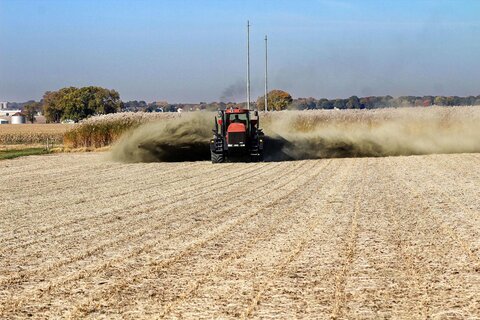
A five-year study at the University of Illinois Energy Farm found applying ground-up silicate rock to Midwestern farm fields can capture significant amounts of carbon dioxide and prevent it from accumulating in the atmosphere.
Working with Eion Corp., researchers at the University of Illinois Urbana-Champaign and the Leverhulme Centre for Climate Change Mitigation (LC3M) developed a new method to calculate the CO2-reduction potential of basalt rock amendments applied to cropland soil, a process known as enhanced weathering.
Researcher Evan DeLucia, who is director emeritus for the Institute for Sustainability, Energy and Environment (iSEE), as well as U of I professor emeritus of plant biology and co-investigator for the Center for Advanced Bioenergy and Bioproducts Innovation (CABBI) at Illinois, partnered with researcher Ilsa Kantola, who is a research scientist at iSEE and the Carl R. Woese Institute for Genomic Biology to study how enhanced weathering could potentially be used as a carbon-capture tool.
The research team was able to successfully quantify the carbon-capture potential by calculating both the weathering rate and CO2-reduction potential of the basalt rock when applied to maize and miscanthus fields, components that are critical to optimizing carbon sequestration efforts.
The researcher’s calculations showed that enhanced weathering reduced net carbon loss to the atmosphere by 42% in maize plots. Paired with conservation tillage or cover crops, the basalt application could turn maize into a net carbon sink.
In miscanthus plots, which already stored more CO2 than they emitted before the addition of basalt, enhanced weathering more than doubled carbon storage. The finding adds to the potential climate benefits of this renewable bioenergy crop, one of three targeted by CABBI in its U.S. Department of Energy-funded work.
“In addition to reducing emissions, we desperately need effective ways to draw down atmospheric carbon dioxide. Our results suggest that basalt application to farms could be a win-win for farmers and for the planet, improving yields and drawing down CO2,” said DeLucia.
With enhanced weathering, silicate rock is applied to farmland to capture carbon before it reaches the atmosphere. As the rock weathers, calcium and magnesium are released and react with dissolved CO2 to produce bicarbonate, essentially locking up the gas and redirecting it into groundwater.
The Illinois team repeatedly applied finely-ground basalt on twin fields at the Energy Farm for four years — one field with a maize-soybean crop rotation and the other with Miscanthus x giganteus, a perennial grass that is emerging as a productive bioenergy crop to replace fossil fuels.
The team found grinding the basalt accelerates a natural weathering process that involves two chemical reactions.
First, atmospheric CO2 dissolves in rainwater to create carbonic acid, which reacts with the existing rock dust in the soil to form bicarbonate that is a soluble compound that leaches with the soil water.
The bicarbonate redirects the CO2 from the atmosphere to the water cycle, where it can pass harmlessly into waterways and potentially help fight ocean acidification.
Basalt also benefits soil fertility because it contains both calcium and magnesium, as well as phosphorus and minor nutrients that are released during weathering.
The Illinois team calculated the CO2 reduction and weathering rate of the basalt by measuring the change in rare earth elements in the soil with the addition of basalt and comparing it to the calcium and magnesium in the system.
The rare earth elements are “sticky,” meaning they build up in the soil in tiny amounts as more basalt is applied, and calcium and magnesium are released by weathering, with some taken up by the crops.
The difference in rare earth elements indicates how much basalt, and therefore how much calcium and magnesium, has been applied; and the difference between the expected amount of calcium and magnesium and the actual amount in the soil tells researchers how much has been consumed by reactions in the soil.
The amount of basalt needed depends on the composition of the rock and environmental conditions where it is applied.
“As we look for new ways to offset carbon emissions, we need to be able to quantify those carbon savings to better compare our options,” Kantola said.
The work is part of iSEE’s partnership with the Leverhulme Centre at the University of Sheffield in the United Kingdom, which is investigating enhanced weathering for carbon dioxide removal in field sites around the world including in Malaysia, Australia, the U.K. and the United States.
CO2 removal methods are a critical part of climate mitigation strategies and pressure is growing to implement these strategies soon.